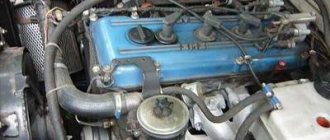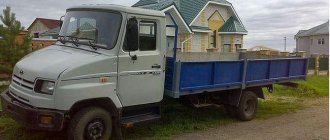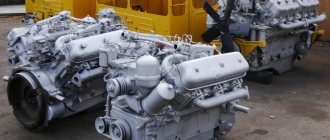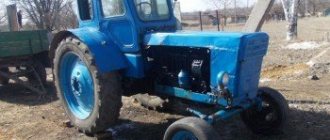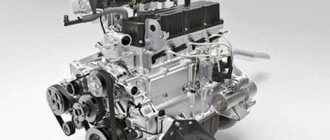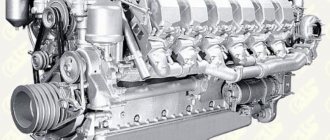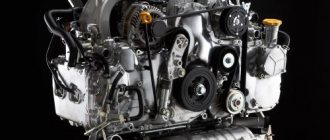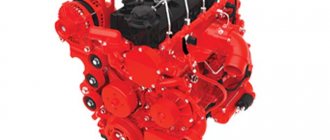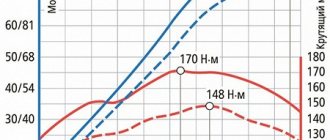The GAZ 66 truck, produced at the automobile plant in Nizhny Novgorod, is a mass product that powers the GAZ 66 engine of the same name. The period when the unit was made covers the time period from 64 to 99. During this time, they managed to develop three generations of vehicles with two axles, a 4x4 or 2x4 wheel arrangement and the ability to transport a load weighing two tons.
As for the power plant, the product was ordered from the Zavolzhsky Motor Plant, where the characteristics of the latter were calculated by both its own employees and GAZ employees. The product is named after the name of the car, however, the official marking is “ZMZ-513”. The motor was repeatedly modified and improved, and as a result, at that time the product was considered exemplary in its class. The unit is still relevant today, so production has not been discontinued.
The appearance of the motor
Calculations for the car and power plant began at the turn of the fifties. Initially, the vehicle was intended for universal use, like an all-terrain vehicle. The military was primarily interested in the product; agriculture also needed such devices. It is no coincidence that the car was used by geologists, workers in the oil and forestry industries.
When creating the car, the GAZ 66 engine was also developed from scratch; the technical characteristics of the installation corresponded to the trends of that time, ahead of competitors. The creation of the unit was the responsibility of designers and engineers who took the work seriously, and as a result, the set conditions were met. The motor turned out to be simple, reliable, durable, and the product was repaired in the field.
The first cars rolled off the assembly line in 1962, and serial production of cars began in 1964. The “finest hour” of GAZ 66 came in 1967, when the Gorky – Vladivostok – Gorky run was organized. The vehicle easily covered the route, part of which was off-road (Ural, Siberia, Transbaikalia, Far East). Both the car and the engine passed the test with honor, without receiving any serious damage.
Production of the car continued until 1995; later the unit was replaced by the GAZ-3308, which replaced the modification. The improved ZMZ-513 power plant, used on the 66th, is still produced today. The product is used on other modifications of GAZ vehicles, including “3308”.
ZMZ-66
Initially, they used the basic model GAZ-66, which was labeled by the manufacturer as “ZMZ-66”. The power plant was produced at the Zavolzhsky plant; it is a carburetor engine with eight chambers, four strokes, water cooling and a “V” layout. The engine had a volume of 4.254 liters, developed 120 horses and 284 Nm of impulse. The chamber cross-section was 92mm, the displacer stroke was 80mm. With these values, the compression was at 6.7, the weight of the unit was 262 kg. Together with the design, a carburetor of the K-126 model was used, later the product was replaced by the K-135. The engine was powered by A-76 gasoline, fuel consumption was 25 liters per hundred. To operate in sub-zero temperatures, a start-up heater was installed.
ZMZ-513
In the early 90s, the GAZ-66 engine (“ZMZ-66”) was replaced with the “ZMZ-513”. This is a four-stroke power plant with a “V” layout, running on gasoline with the formation of a mixture by a carburetor. The motor is liquid cooled and assembled at the same Zavolzhsky plant. The design of the engine is successful, which is why the product is still produced today. Structurally, the unit is similar to its predecessor, but there are differences. The device is more compact, the block and head are made of aluminum, the volume has not changed (4.254 liters). The product develops 125 horses, impulse 284 Nm, compression 7.6.
New injection V8 ZMZ-5245.10 Photo. Upgrade of Soviet classics — DRIVE2
injection V8 ZMZ-5245.10
Officially about the new engine
We are pleased to announce the start of production of an interesting modification of the good old engine, which begins its history with the GAZ-53 and GAZ-66. This is a new injection tri-fuel V8 engine ZMZ-5245.10. Those. it has modifications to operate on gasoline + natural gas, gasoline and gasoline + propane-butane. The ZMZ-5245.10 engine and its version of environmental class 5 are initially intended for installation on PAZ-3203, PAZ-3205, PAZ-3206 buses and their modifications, produced by the Pavlovsk Bus Plant. The ZMZ-5245.10 engine and its eight-cylinder, V-shaped engine are equipped with an integrated microprocessor control system for fuel supply and ignition. Electronic control unit Mikas. Camshaft with high lift, for 3200 rpm. We added hydraulic compensators to the rocker arms. Quite a lot of modifications have been made to refresh the engine.
injection ZMZ-V8 5245.10
According to the liter-revolution-power ratio: the very first injector 14th 1972 5.53 liters at 4600 rpm = 25438 groove-eng. 4.67 x 3200 = 14944 the power of the groove-engine should be 59% of the injector of ’72, where there were 238 gross horses, which means the groove should have a power of 140 horses, and according to the schedule 138, everything more or less converges.
Well, besides everything else, the diagrams show such a two-level collector, like on the catch-up ZMZ-505, so it’s not all that bad) www.drive2.ru/b/2833079/ This will be especially useful for hot rodders, you don’t have to look old two-level
more about the engine (a little sarcasm and humor)
Those. information www.zmz.ru/files/PP5245.pdf
repost
Likes 458 Shares: Subscribe to author
www.drive2.ru
GAZ-544
In addition to the engines listed above, an attempt was made to switch to diesel units. So, in the 90s, a small batch of GAZ-544 diesel engines was installed on the car. The power of the product is 85 horses, the impulse is 235 Nm. A small series of these engines with a turbine (116 horses) was also used, which received the index “GAZ-5441”. A distinctive feature of the installations is economical fuel consumption (17 liters per hundred), increased service life and productivity. However, the engines did not take root, and the main modification remained “ZMZ-513”.
Technical characteristics of the Gas 66 engine
The power unit is an improved modification of the ZMZ-511 engine. The disadvantage of the product is the installed inlet pipe with one tier. The design results in pulsation of the input flow. The phenomenon has a negative effect on the formation of the mixture; the deficiency is solved by installing an injector. In addition, heads with turbulent chambers and screw inlet channels are used. Such heads made it possible to increase the compression to a level of 7.6 to one.
Do not forget that the motor is technically capable of operating in difficult conditions; for this reason, the unit has been installed on military equipment. In comparison with other modifications used on the GAZ 66, the power plant has a number of differences. For example, a structurally different pallet was installed, profiled for a bridge, electronic equipment with a protective screen, etc.
Characteristics of the GAZ 66 (ZMZ-513) engine:
| Index: | Meaning: |
| Assembly is set up | Motor |
| The motor is produced, period | 64-99 |
| Motor core raw materials | aluminum |
| Motor power | Carburetors: K(126B(M), 135) |
| Motor cooling | Liquid |
| Number and layout of cameras | Eight, "V" |
| Camera operation order | «1 – 5 – 4 – 2 – 6 – 3 – 7 – 8» |
| Bypass valves per chamber, (pcs.) | 2 |
| Chamber cross-section, (mm.) | 92 |
| Motor displacer displacement, (mm.) | 80 |
| Motor squeezing | 7,6 |
| Engine capacity GAZ 66, (l) | 4,254 |
| Power, (horses) | 125 |
| Motor impulse, (Nm.) | 284 |
| Fuel used by the engine, (A) | 76, 80, Gas |
| Motor complies, (Euro.) | «0» |
| Engine weight, (kg.) | 275 |
| Specific fuel costs g/kWh | 286 |
| Loss of engine lubrication, (% of fuel) | 0,4 |
| Engine oil for GAZ 66 | M-5z/10A, M-6z/10V or 10 (15)W40 |
| Amount of lubricant in the motor, (l.) | 10 |
| Changing the lubricant in the engine, (km.) | 6000 -10000 |
| Motor operating temperature, (°C) | 95 |
| Engine life, (km.) | 300000 |
| Tuning potential, (km.) | +100000 |
Description
A special feature of the ZMZ 511 engine is the use of a highly turbulent combustion chamber and screw inlet ports. This ensures maximum fuel combustion, improved engine performance at low speeds and reduced gasoline consumption.
- The cylinder block is made of durable aluminum and has a special reinforced flange, which guarantees maximum durability.
- Compression piston rings are made of high-strength cast iron.
- The ZMZ 511 valve system is also reliable and easy to maintain.
- To meet its stringent environmental requirements, this engine received an exhaust gas recirculation system. Thus, it was possible to significantly reduce CO2 emissions into the atmosphere.
- This power unit has a power of 92 (upgraded version - 125) horsepower at 3200 engine rpm.
- ZMZ 511 was developed for use with low-octane fuel, which ensures reliable engine operation when using A-76 gasoline.
- We also note that it is unpretentious in maintenance, which made it possible to increase the service interval. Apart from changing the oil every 20 thousand kilometers, this engine does not require any significant maintenance. The timing belt is made on the basis of the 1st camshaft, which is located at the base of the block camber. The camshaft drive is gear driven from the crankshaft; the gears are located on the front wall of the block and are covered with a lid. Rods are laid from the camshaft to the heads, which provide drive for the rocker arms and valves. The need to open the engine arises only when the vehicle runs more than 300 thousand kilometers.
- The design of the power unit is simple, which explains the reliability of the engine. The aluminum block with two cylinder heads has a camber angle of 90 degrees. To increase reliability, individual elements that are subject to maximum thermal load are cast from reinforced cast iron, which has increased resistance to thermal effects, which completely eliminates damage to the motor due to overheating.
- The driven disc at the clutch has also been strengthened, which is necessary for high-power engines. This power unit also has a modified design of engine mounts, which reduces vibration.
- The overhead valve design of the ZMZ 511 engine ensures maximum stability and durability of the power unit. This motor is easy to maintain and can run about two hundred thousand kilometers without major repairs.
Motor problems
As already mentioned, the power plant was structurally and technically reliable, durable and simple. The operational characteristics of the GAZ 66, such as engine power, impulse, etc., are sufficient to complete the tasks assigned to the vehicle.
The disadvantages of the product include the difficulty of starting a hot engine. A distinctive feature of the procedure is the tilt of the product at the time of the manipulation; a car standing on a slope does not want to start. For successful launch, press the gas pedal all the way. On a flat surface things are simpler, but not without complications.
A cold engine also has quirks; after some time after starting, the unit stalls, and at idle it shows instability. During operation, the motor does not like braking without disabling the gear. Such actions are accompanied by popping noises in the muffler and increased fuel consumption.
When symptoms appear, the parts of the ignition group (spark plugs, conductors, etc.) are checked. If the cause is not found, the problem is created by the spider. The part is sucking air and needs to replace the sealing element. If the repair does not bring results, the product is replaced. Replacement solves the problem, the motor works without failures.
GAZ 66 intake manifold:
Motor maintenance
For normal operation of the unit, the regulations provide for a number of manipulations, which include:
- Changing the working oil in the engine (15,000 km);
- Replacing the oil filter element of the installation (15,000 km);
- Valve adjustment (30,000 km);
- Replacement of the air filter element (25,000 km);
- Checking and replacing spark plugs (20,000 km);
- Monitoring the condition of the gas distribution mechanism (30,000 km).
Carrying out the above manipulations is the key to maintaining the initial characteristics of the motor at the proper level for as long as possible.
Oil filter for ZMZ-513:
Frame
After the frame was delivered, we quickly carried out an inspection to detect rust. In general, everything was fine, the frame was well preserved during use, it was only slightly covered with rust, and the fastening of the second vacuum was completely rusted.
The vacuum was hanging on the “snot”, we removed this vacuum because it was not needed. My father, armed with an iron brush, cleaned the frame of rust in a couple of hours. The old tank mount was removed. They decided to put a new tank in this place.
Engine options for GAZ 66
The standard engine, ZMZ-06, was a gasoline carburetor 8-cylinder unit with a capacity of 120 hp. s., and on a car with a gross weight of 5770 kg. had justified complaints against himself. It was also possible to install a forced ZMZ 41 carburetor engine with a volume of 5.53 liters.
The stock engine with a displacement of 4.25 liters, had a V-shaped arrangement of eight cylinders and with a torque of 29 kgm, allowed to produce 120 horses.
installed engine on GAZ 66
Since a considerable number of cars are in working order these days, private car enthusiasts have many of them, especially from the outback, sometimes there is a need to modernize the power plant. One of the main options was the engine of Belarusian manufacturers.
The diesel engine of the Minsk Motor Plant of the D-245 family, for example, the D-245.9, which compares favorably with its gasoline counterpart in power (136 hp) and fuel, since it consumes diesel fuel. And it has better torque (maximum – 47 kgm).
Diesel engine D 245 for Gas-66
By default, this product of the Belarusian automobile industry is installed on ZIL 131 and ZIL-130 cars.
Since the D-245.9 is used mainly in the field of cargo transportation, there are modifications with turbocharging.
Engine options are also available with indexes E2, E4. That is, their performance characteristics correspond to the Euro 2 and Euro 4 standards. But, probably, in relation to the GAZ-66 from military conservation, this criterion will not be fundamental in the decision to install this particular unit on your car.
Tuning
The power of the power unit is 92 horsepower at a rotation speed of 3200 rpm.
The engine with a volume of 4.25 liters has a significant reserve for increasing power.
It must be said that even such a major tuning of the ZMZ 511 practically does not change the engine life.
- Some craftsmen, by completely re-sharpening the engine and installing a turbine on it, increase the power to a level of 200 horsepower.
- Changing the operation of the carburetor system is a popular type of tuning. Even one reconfiguration of the carburetor can give an increase of 4-5 horsepower. You just have to understand that such an increase in power is achieved solely by increasing the enrichment of the mixture. As a result, fuel consumption increases, which is often critical when using a vehicle for long-distance transportation of goods.
- The installation of special injectors on the ZMZ 511 engine is very popular, which allows optimizing fuel consumption and improving the behavior of the car at low engine speeds. We recommend using injectors from other GAZ models.
- Using a machined flywheel can provide an additional 3-5 horsepower, depending on the specific flywheel option. You just need to remember that such excessive grooving can lead to a deterioration in the strength of this element, and the engine itself begins to operate unstably under minimal load.
- The use of lightweight pistons and crankshaft allows you to add about ten more horsepower. We only note that such deep tuning is not popular, since these works are characterized by increased complexity, and the effect of ten additional horsepower does not lead to a radical improvement in the behavior of the car. Such deep tuning will be justified in cases where the engine is being overhauled and restored after serious breakdowns.
- Installing a turbine on the ZMZ 511 engine will be the most radical and quite effective way to increase engine power. It is only necessary to correctly determine the characteristics of the turbo systems used, which will increase the power of the power unit without losing the resource of the power unit.
- Keep in mind that tuning the ZMZ 511 using a turbo should be performed by a professional specialist, which will allow you to avoid any problems with the reliability and performance of the engine.
- The power of the ZMZ 511 engine can be increased by installing a modernized exhaust system, which will add about 5-8 more horsepower. The exhaust system used initially suffocates the engine and reduces its power. By cutting out a few cans and installing a direct exhaust, you can increase the engine power, which will invariably affect the dynamics of the car. Just remember that in this case the environmental friendliness and noise levels of the car may deteriorate.
Engine D 245 9
Now let’s look in a little more detail at the features of the D-245.9 engine, since this model is more common. And home craftsmen often modernize the “Shishiga” with this power unit.
Diesel D-245.9 is a 4-cylinder internal combustion engine, with an in-line arrangement of cylinders, a 4-stroke operating cycle and compression ignition of the air-fuel mixture. The engine is started by rotating the crankshaft, which is transmitted from the electric starter to the shaft by the flywheel.
Diesel fuel is injected in a finely atomized state at the very end of the compression stroke, as a result of which the combustible mixture ignites and the piston moves downward, being under pressure due to the expansion of the combustion products of the air-fuel mixture.
For more economical and practical use of fuel, the nozzles through which diesel fuel is injected into the cylinder are equipped with high-speed magnetic valves. This approach became possible due to the introduction of electronic engine control.
This is what the D-245.9 diesel engine looks like
If the requirements for compliance with Euro standards are met, an exhaust gas recirculation system (EGR - exaust gas recirculation) is included in the engine layout. In this case, part of the exhaust is returned to the cylinder, where nitrogen oxides are “afterburned” to inert N2O. A particulate filter with an oxidizer-neutralizer is also installed.
GAZ 53 Gas 52-04 GAZyonysh › Logbook › Injector, switch, chip tuning... no, I haven’t heard of it.
Hello again! Today we will talk about (to put it mildly) unstable engine operation and how I dealt with it
